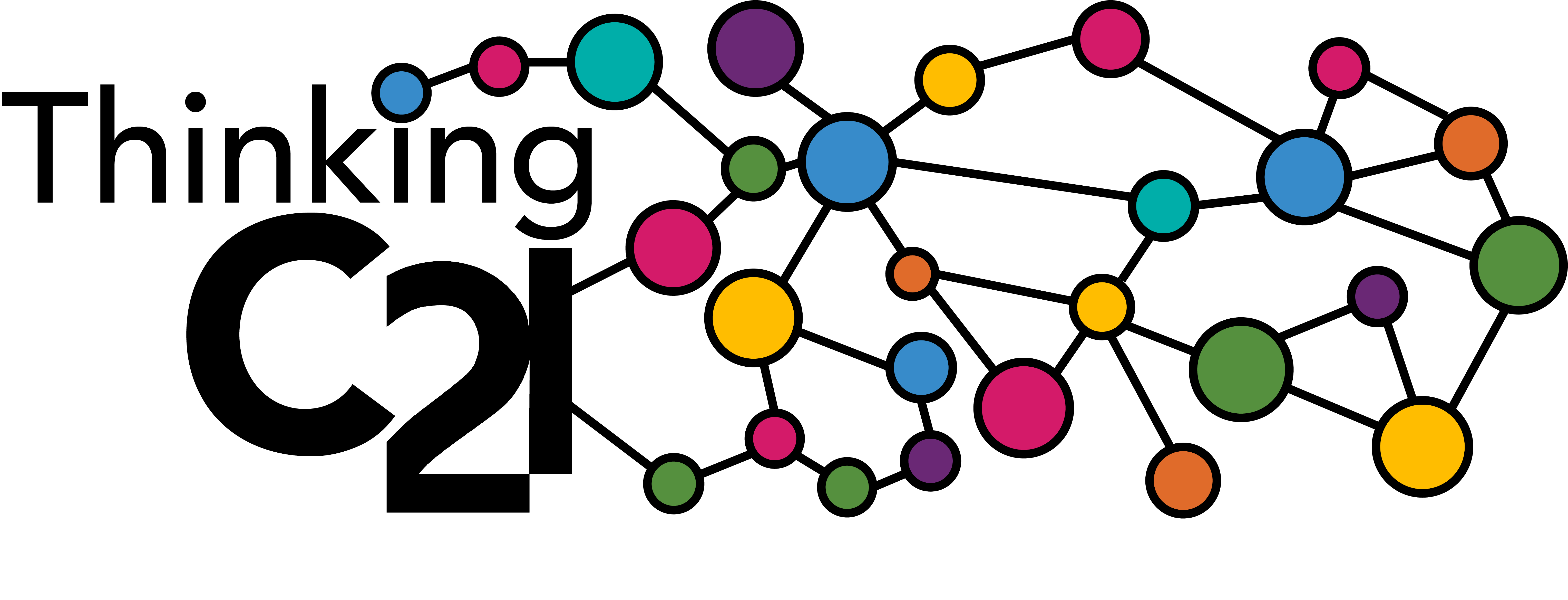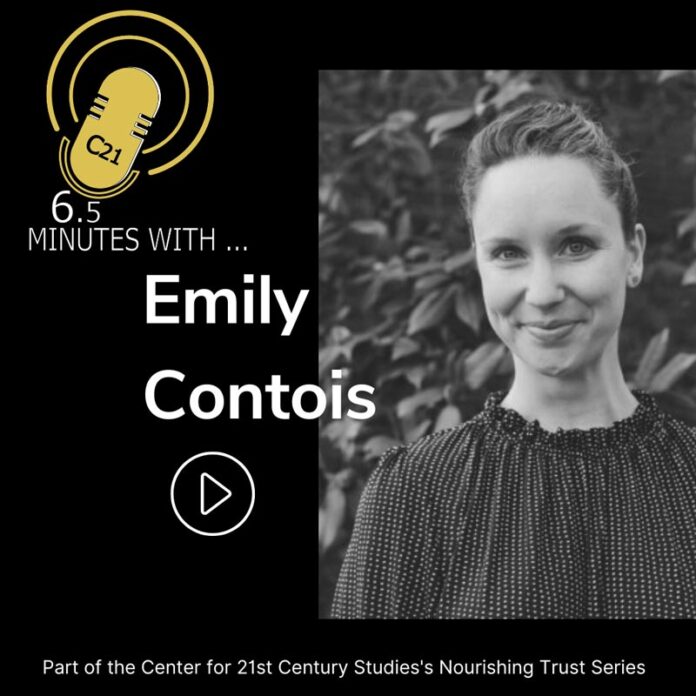American, food, and media studies expert, Emily Contois, talks through the intersection of gender, food, and power and introduces her book, Diners, Dudes, and Diets (2020).
Transcript of the podcast:
Randolph Marcum:
You’re listening to 6.5 Minutes with C21. An audio introduction to the topics, experts, and leaders who take part in the conversations hosted by the Center for 21st Century Studies. I’m Randolph Marcum, a graduate fellow at C21. In this episode, Deputy Director Nicole Welk-Joerger interviews Dr. Emily Contois, an assistant professor in Media Studies at the University of Tulsa. Her 2020 book Diners, Dudes, and Diets served as the basis for their conversation.
Nicole Welk-Joerger:
How does gender impact our conversations about food and power? Especially given it’s the tagline of this book Diners, Dudes, and Diets.
Emily Contois:
Absolutely. So, I think that the tagline there is, you know, not just gender but power, right? Of understanding where do ideas about gender come from, particularly a gender binary, right? How does that come to be so strictly sort of defined and enforced and repeated throughout culture when we know, right, that gender is a social construction, it’s only what we make it, right? It’s just through repetition that it comes to be reinforced and to mean something. And so, I was so fascinated and disappointed at the same time, right, to see how our food media escape does a really strong job of reinforcing these really conventional and even regressive ideas of what femininity is as it comes to be attached to food and flavor and appetites, particular dishes and ingredients, the way that we eat, the ways that we cook and how we think about our bodies, what we hope for them to look like and feel like. And so much of that is this real, just such a strict sort of binary construction of who we are when it comes to femininity and masculinity alone.
And so, part of what I had to do with the book is to show how do these hegemonic forms, right, sort of come to be so that we can understand how to reconfigure and reimagine them so that we can create a food life, right, where there is this space for justice and joy as we imagine who we are through gender identity. And of course, aspiring to an intersectional analysis that also thinks about race and sexuality, region, religion, all these other questions as well. And so, what I look at in the book is how did, you know, the food, media and marketing industries attempt to sell what were perceived to be feminized products to men? So, things like diet soda and yogurt and cookbooks and food television, and of course, the crème da la crème of like weight loss programs. How does weight watchers try to sell themselves to men? And so, what I argue is they have to construct a particular kind of masculinity to do it. So, that’s where The Dude comes in. So, The Dude is our slacker hero, right? He can partake in food from this cool distance with this nonchalance that he doesn’t really care about anything. He has the privilege that he doesn’t have to care about anything. And so, in that way, you know, The Dude was certainly something that was repeated through media marketing, images, messages.
Nicole Welk-Joerger:
You also helped co-edit this collection called Food Instagram, which really goes into the social media landscape. Food justice is a big concept with multiple dimensions. How might we read Diners, Dudes, and Diets or the collection of Food Instagram with food justice in mind?
Emily Contois:
Definitely. I think one of the things we were so interested in studying food Instagram was this idea of Instagram ability, right? What photos of food? What aesthetic conventions? What set of rules gets to define, right, of food image that’s worth taking and sharing on the platform and potentially, you know, going viral and getting likes and sort of influencing a conversation. And so, for that to become so exclusive, right, then required a certain amount of sort of technical proficiency. You know, aesthetic creation from everyday users, right, wanting to take photos of their food. You know, I do food Instagram assignments with my students, and they feel that pressure, right, that their photos have to be good enough to be able to share them on Instagram thinking of people who desire to be content creators or influencers. These sort of aesthetic conventions shut some people out of who is able to be a part of those conversations and then also thinking in the food business space that very early on, you know, upwards of 80% of restaurants were on Instagram. This was a platform for connecting with consumers for sharing your food. For showing, you know, dishes that consumers could come and take beautiful photos of. That chefs start designing dishes for Instagram and for how the camera eats first. As well as things, you know, like beautiful restaurant spaces with great lighting, specifically for taking photos with feature walls or murals, all sorts of beautiful things to bring us into a restaurant space. And so, in some ways that can be quite exclusionary, right? These sort of standards for beauty and what foods supposedly should look like, at least within the world that Instagram creates. But at the same time, part of what we love so much in the book is seeing how users push back against the supposed rules and affordances of the app and of what it asks us to do that we can push back against that and use Instagram and lots of other ways, including creating community of finding others with similar interests or similar problems and be able to create a beautiful sense of connection in the digital space.
Nicole Welk-Joerger:
Given your work, how might we want to think about the relationship between trust and food, especially based on some of the things we’ve been talking about today?
Emily Contois:
I think one of my favorite things about trust and food is thinking about the historical roots of our like national food system, right? When we go from having a much smaller food shed and truly knowing the people who grew your food or slaughtered the animals or provided the milk or whatever. That once we have a railroad system and, you know, refrigerated railcars and then national branding. Like this is where the media and advertising piece comes in that like the stories about food are then to told through brands and logos and commercials, and all those sorts of images that are trying to create a sense of place, a sense of story, a sense of identity. And so, this idea of like, can you trust a food system where it isn’t just a local transparent arm’s length away sort of a food system. For a lot of us to partake in a national food system is to be one where there’s less easy trust that the trust has been displaced onto brands. And so, I find this particular moment with marketing advertising really interesting with things like corporate social responsibility, or these sorts of campaigns that are cause-driven. What does it mean for a brand to take a stand on Black Lives Matter or the MeToo movement or any climate crisis, right? Any of a number of big issues, big causes that are rooted. Environmental justice. Race is justice. Gender. Justice is at the center of it all.
Randolph Marcum:
To further engage with this interview, please visit our website at uwm.edu/c21. If not there, we hope to catch you when you have another 6.5 Minutes to spare.








